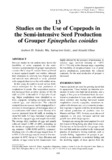Studies on the use of copepods in the semi-intensive seed production of grouper Epinephelus coioides

Tingnan/
Petsa
2005Page views
591Metadata
Ipakita ang buong tala ng itemCited times in Scopus
Share
Abstract
Previous studies by the authors have shown the feasibility of using copepods in the semi-intensive seed production of grouper Epinephelus coioides. Early-stage E. coioides larvae preferred to ingest copepod nauplii over rotifers, although their abundance is relatively low. Higher growth and survival were obtained in larvae provided with copepods than larvae fed with rotifers alone. In this study, the authors tested various fertilization techniques for the mass production of zooplankton in ponds. The zooplankton population increased from an initial density of 86–148 ind/L to 1,524–3,186 ind/L 9–12 days after flooding. Major zooplankton were identified as rotifers, copepods, including cyclopoid and harpacticoid spp., and cladocerans. The calanoid copepod Acartia tsuensis can be propagated in 1-ton tanks in mixed species of microalgae alone or in combination with baker’s yeast. Density of A. tsuensis increased from 60 ind/L at stocking to about 900 ind/L 3–5 days thereafter. A prototype collector for copepod eggs and nauplii was tested. The average daily numbers of eggs and nauplii collected varied (2,300–117,600), depending on the density of copepodids and adults in the holding container (1,000–8,000 ind/10-L container). Hatching rates of collected eggs ranged from 34 to 89%. Collected eggs may be stored at low temperature (4–10°C) for up to 7 days. Duration and viability of eggs stored at low temperature were highly affected by the presence of protozoans. A. tsuensis eggs survived freezing to –20°C (0.3–1.7%) only at the cleavage stage, suggesting the feasibility of cryopreservation. Use of pond grown zooplankton, particularly the calanoid copepods, for the seed production of grouper is discussed.
Suggested Citation
Toledo, J. D., Golez, M. S., & Ohno, A. (2005). Studies on the use of copepods in the semi-intensive seed production of grouper Epinephelus coioides. In C.-S. Lee, P. J. O’Bryen, & N. H. Marcus (Eds.), Copepods in Aquaculture (pp. 169-182). Ames, Iowa, USA: Blackwell Publishing.


